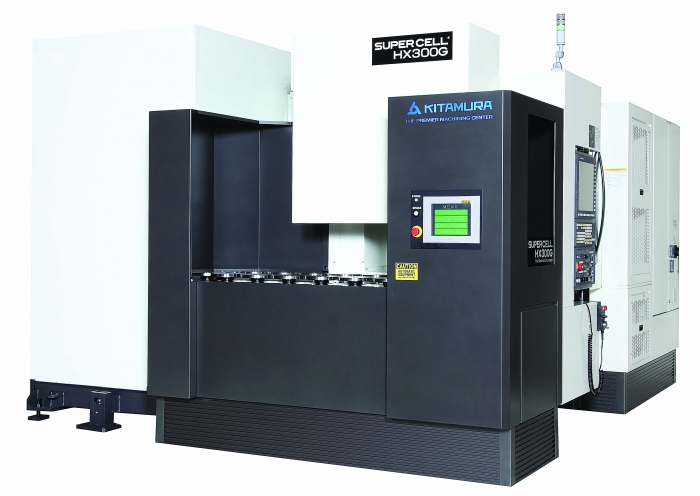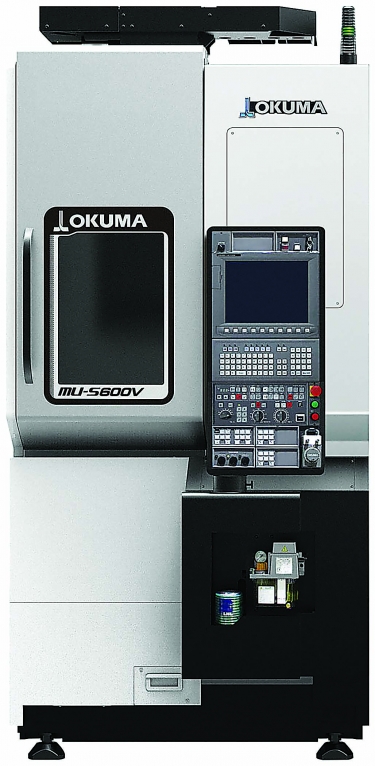Whether your preference is a vertical or horizontal unit, you can buy a new machining center that automates the production process without hogging too much space on the shop floor.
One example is the recently introduced Supercell-300G 5-axis horizontal manufacturing cell from Kitamura Machinery of USA Inc., Wheeling, Illinois. Able to hold 20 pallets in a 149"-wide footprint, the Supercell-300G is capable of unmanned production of small and medium-size parts made of a variety of materials, including stainless steel, titanium, Inconel and aluminum. The machine offers 2µm positioning accuracy and 1µm repeatability, according to Sal Swierczek, Kitamura’s assistant sales manager.

The Supercell-300G 5-axis horizontal manufacturing cell is for unmanned production of small and medium-size parts. Image courtesy of Kitamura Machinery of USA
Although the machine comes standard with a 20-station automatic pallet changer, arrangements with as many as 80 pallets are available as an option. The pallet tables are 7.9" in diameter, so the machine wouldn’t be the right choice for manufacturing large parts, Swierczek noted.
Located in front of the machine, the pallet changer features Kitamura’s unique “wide open” design that gives operators access to all the pallets at any time, according to Swierczek. “With this pallet magazine, customers can load their parts onto the pallets and then go on to other tasks,” he said. “For companies that don’t have many employees, that frees them up to do other operations or attend to other machines.”
In addition, the HMC offers a so-called “dual-contact” spindle. Normally, the toolholder makes contact with the spindle in only one place. For increased rigidity, however, this machine’s standard 20,000-rpm spindle touches both the toolholder shank (taper) and flange.
The Supercell-300G also comes with a 174-tool matrix-style automatic toolchanger. The matrix magazine allows many tools to be loaded in a relatively small space and can also speed up tool changes in applications involving complicated parts that require a large number of tools. Additionally, Swierczek pointed out that the tool matrix enables the machine to “stage” tools so they are in position to be tapped for upcoming operations, which reduces tool-changing time.

Featuring built-in robotics, the MU-S600V VMC can automatically pass parts off to another machine of its kind for additional machining operations. Image courtesy of Okuma America
Like the Supercell-300G, the new MU-S600V vertical machining center from Okuma America Corp., Charlotte, North Carolina, is capable of unattended operation. In addition, Okuma says this VMC offers unique automation capabilities. The MU-S600V is designed to connect to one or more machines of the same type and use built-in robotics to transfer parts from one machine to another.
Though it measures just 1,400mm wide, the slender VMC can machine 600mm-dia. workpieces. All six sides of a workpiece can be machined in a single two-machine setup using Okuma’s work-handoff system.
“Rather than someone going inside the machine and flipping the part around to finish up, it’s flipped around automatically when it’s passed off to the other machine,” said Errol Burrell, machine center product specialist for Okuma.
Besides handling multisided parts, shops may have to produce parts with odd angles or features that require a second machine, he said. With the MU-S600V, these shops have the option of adding another machine to create an automated process that requires no extra transport equipment for moving parts between machines.
According to Burrell, Okuma is receiving many inquiries from shops interested in using the MU-S600V to create a two-machine work cell. Some potential customers, however, have discussed going much further. “People have been talking about four or five machines in a row all passing the part off to the next machine,” he said.
How big could such systems grow? “There has to be a limit,” Burrell said, “but at the moment, I don’t know what that limit is.”
Related Glossary Terms
- automatic toolchanger
automatic toolchanger
Mechanism typically included in a machining center that, on the appropriate command, removes one cutting tool from the spindle nose and replaces it with another. The changer restores the used tool to the magazine and selects and withdraws the next desired tool from the storage magazine. The changer is controlled by a set of prerecorded/predetermined instructions associated with the part(s) to be produced.
- machining center
machining center
CNC machine tool capable of drilling, reaming, tapping, milling and boring. Normally comes with an automatic toolchanger. See automatic toolchanger.
- robotics
robotics
Discipline involving self-actuating and self-operating devices. Robots frequently imitate human capabilities, including the ability to manipulate physical objects while evaluating and reacting appropriately to various stimuli. See industrial robot; robot.
- shank
shank
Main body of a tool; the portion of a drill or similar end-held tool that fits into a collet, chuck or similar mounting device.
- toolchanger
toolchanger
Carriage or drum attached to a machining center that holds tools until needed; when a tool is needed, the toolchanger inserts the tool into the machine spindle. See automatic toolchanger.
- toolholder
toolholder
Secures a cutting tool during a machining operation. Basic types include block, cartridge, chuck, collet, fixed, modular, quick-change and rotating.


